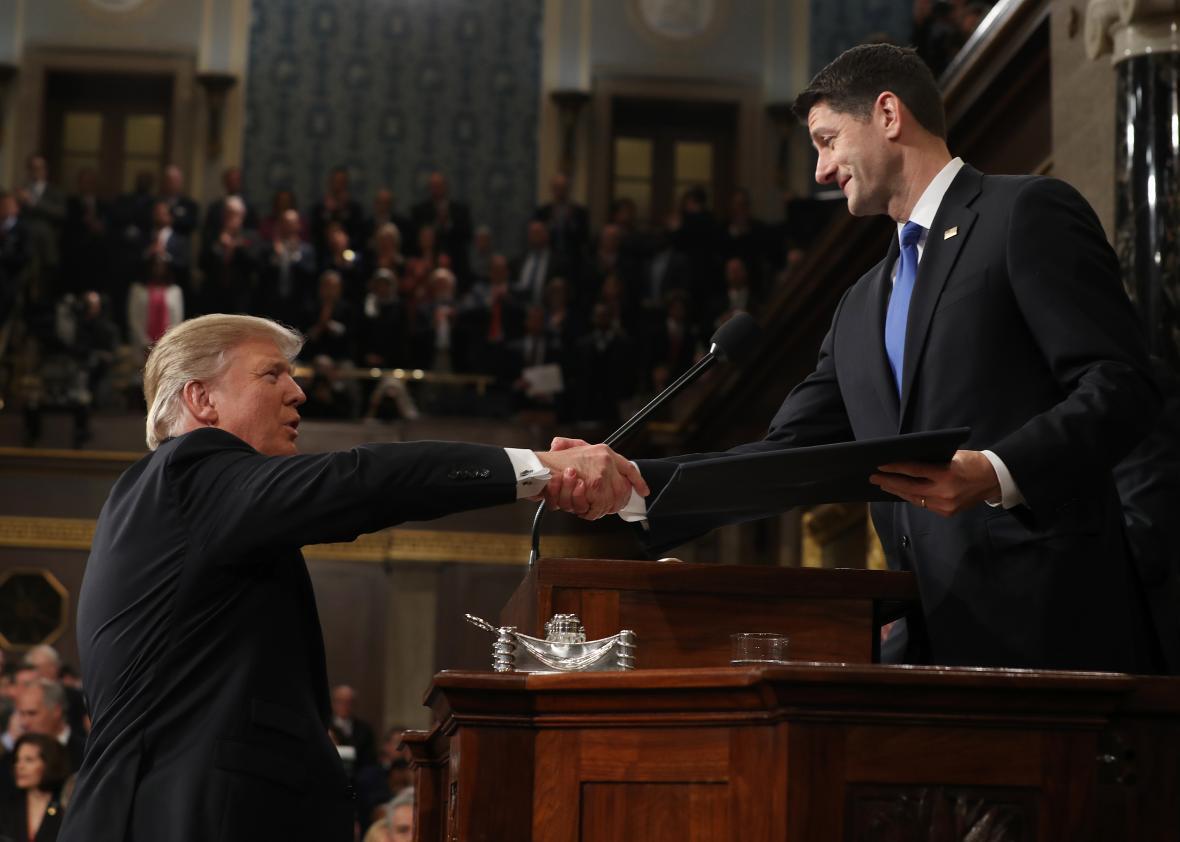When House Republicans unveiled their plan for replacing the Affordable Care Act last week, a number of health policy experts, including conservatives, worried that it looked like a blueprint for insurance market chaos. The legislation had all the ingredients for a severe adverse selection problem—where sick people buy coverage, healthy people don’t, and insurers can’t make money, leading them to raise premiums or stop selling plans.
This week, the Congressional Budget Office disagreed. It suggested that after a brief period of turbulence, Trumpcare would result in a “relatively stable” market, in which “most areas of the country would have insurers participating” and customers would “not be subject to an unsustainable spiral of rising premiums.” In the context of a document forecasting that 24 million people stood to end up uninsured due under Trumpcare, this counted as good news.
Why are the budget wonks so optimistic? Their reasoning is sort of idiosyncratic but makes sense in the greater scheme of the CBO’s report.
Let’s start with a quick review of why some people, myself included, are concerned that Trumpcare could send the insurance markets into fits. In short, the legislation guarantees that sick Americans can buy coverage without balancing them out by forcing healthy people to purchase it as well. It keeps in place Obamacare’s old rules prohibiting carriers from discriminating against customers with pre-existing conditions, while eliminating the individual mandate requiring people to obtain insurance or pay a tax penalty. In its place, Republicans would create a rule obligating insurance companies to charge people 30 percent extra for a year if they buy a plan after going uninsured for about two months. This is meant to encourage young and healthy people to stay covered (and pay premiums that subsidize the sick) lest they get hit with the penalty. But by making coverage more expensive, it could just as easily discourage the uninsured from enrolling in the first place.
The upshot: Sick people will still be able to buy insurance while healthy people will have incentives to hold off until they absolutely need coverage. One conservative health care expert, Avik Roy, wrote that it seemed “like a recipe for adverse selection death spirals.”
As Sarah Kliff noted at Vox, insurers themselves seemed much less worried about this than the wonks. In their view, the individual mandate hadn’t been all that successful at getting people to buy coverage in the first place—adverse selection already seems to be a problem in some states, which is one reason why carriers have had trouble earning a profit under the Affordable Care Act—and Trumpcare’s continuous coverage penalty probably wasn’t going to work all that differently.
The CBO’s analysis doesn’t really mesh with either of these perspectives. Unlike the insurers, the office’s staff believes that the individual mandate is extremely powerful—the agency estimates about 14 million fewer Americans will obtain health coverage in 2018, largely because the mandate will disappear. Like some of the wonks, it also thinks that Trumpcare’s continuous coverage penalty is counterproductive—the office predicts that in most years after 2018, about 2 million fewer people will buy coverage because of the surcharge. And yet, after a couple years of rising premiums and fast-declining enrollment, it projects the market will settle down.
There are basically two reasons why: First, the Republican plan would nudge a lot of old, costly customers off insurers’ rolls. Second, it would fork over a lot of government money to make sure carriers don’t lose too much on the extremely sick.
Trumpcare is designed to lower the cost of insurance for young adults while increasing it for older Americans—it allows carriers to charge near-seniors five times as much as twentysomethings, instead of three times as much, like under Obamacare. As a result, the CBO essentially thinks a lot of 60-year-olds will get priced out and replaced by younger customers lured by cheap coverage. The result is a smaller, healthier, more profitable customer base. The Republican proposal would also give states billions of dollars each year for “stabilization funds”—which they could use to compensate insurers for the cost of covering particularly ill customers. (The Affordable Care Act had a temporary reinsurance program that did largely the same thing). That, the CBO thinks, should stabilize the industry’s bottom line, even if its customers are a little more sickly than expected, and keep insurers in the market.
It’s not an absurd theory of the case. But it is a depressing one. Congress’ official forecaster thinks that Trumpcare would create a steady market where insurers are happy to sell coverage by making it unaffordable for the older Americans who need help most, while supplementing the system with government cash. The CBO’s definition of “stable”—a market where “most areas of the country” have insurers to pick from—doesn’t exactly inspire great confidence, either. After all, voters are already angry because a third of U.S. counties are down to one insurer on the ACA’s exchanges. Having a functioning market in “most” of the country, rather than all of it, might not cut it politically.
And hey, the CBO also says that left to its own devices, Obamacare would end up just as stable—except 24 million more people would have insurance coverage. Just something to consider.
